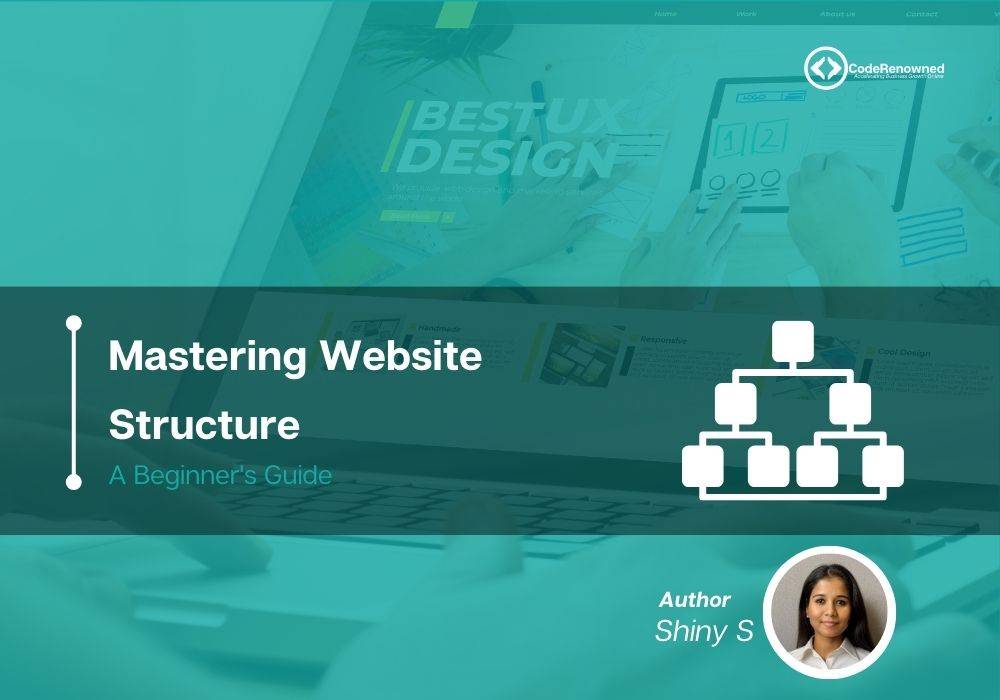Mastering Website Structure
A Beginner's Guide

In the digital age, having a well-structured website is essential for success. The website acts as the virtual storefront for a blogger, an entrepreneur, or a business owner to represent the brand and engage with the audience.
Mastering website structure can be unsettling for beginners as numerous factors are to be considered, from navigation to design and content organization to SEO.
In Below, the sweeping guide, Let’s delve into the fundamental principles of website structure and provide actionable tips for beginners to create a website that stands out in the vast online era.
Understanding Website Structure
Define Your Goals
Before dipping into the technical aspects of website structure. The essential goals to clarify are below:
- What do you aim to achieve with your website?
- Are you looking to sell products, share knowledge, or promote your services?
Understanding this objective will shape the overall structure and design of your website.
Plan Your Navigation
- Navigation is the backbone of a well-structured website, determining the users through the content and finding what they’re looking for.
- Keep the navigation simple and intuitive with clear categories and logical orders.
- Consider using dropdown menus or a sidebar to organize content effectively.
Create a Sitemap
- A site map of the website’s structure is a visual representation that summarizes all the pages and their interconnection.
- Creating a sitemap helps to visualize the ranking of your website and identify any gaps or monotonies in the content organization.
Optimize for User Experience (UX)
- User experience plays a crucial role in website structure.
- Aim to create a seamless browsing experience for the visitors, with fast loading times, intuitive navigation, and mobile responsiveness.
- Attend to design elements like font size, color contrast, and whitespace to enhance their readability and usability.
Designing Your Website
Choose the Right Platform
- Selecting the right platform is the first step in building the website.
- WordPress, Wix, Squarespace, and Shopify are popular options, each offering unique features and customization options.
- Evaluate the needs and preferences to choose the platform that suits your requirements.
Select a Responsive Design
- The increasing usage of mobile devices leads to a responsive website design.
- Ensure that the website adapts seamlessly to different screen sizes and devices.
- Provide a consistent user experience across desktops, tablets, and smartphones.
Design with Accessibility in Mind
- Accessibility is a crucial aspect of website design to ensure the content is accessible to users with disabilities.
- Use alt text for images and deliver captions for videos.
- Ensure the website is navigable using keyboard shortcuts for users who depend on convenient technologies.
Incorporate Visual Elements
- Visual elements like images, videos, and infographics enhance the visual appeal of the website to engage with the audience.
- Use Visual elements wisely and ensure they complement the content rather than distract from it.
- Optimize images for net use to improve loading times.
Organizing Your Content
Define the Content Strategy
- A well-defined content strategy improves creating, publicating, and managing website content.
- Identify the target audience, research keywords, and plan the content calendar to ensure consistency and relevance.
Structure Your Content
- Organize the content into different categories and subcategories to facilitate navigation and discovery.
- Use descriptive Headings and subheadings to break the content into digestible fragments and improve readability.
- Include internal linking to connect related content and improve SEO.
Create Compelling Landing Pages
- Landing pages are essential for capturing the attention of visitors.
- Guide them for a specific action like purchase making, signing up for a newsletter, or downloading a resource.
- Design visually appealing and informative landing pages with clear calls to action to encourage conversions.
Optimize for SEO
- Search engine optimization (SEO) is paramount for driving organic traffic to the website.
- Conduct keyword research to identify relevant keywords for the content.
- Include keywords naturally into the titles, headings, and body text.
- Optimize meta tags, URLs, and image alt text for improved search visibility.
Monitoring and Optimization
Track Your Website Performance
- Monitor key metrics like traffic, bounce rate, and conversion rate to measure the effectiveness of the website structure and content.
- Use web analytics tools like Google Analytics to track user behavior and identify areas of improvement.
Conduct A/B Testing
- A/B testing compares different versions of the website elements and determines performance better in user engagement and conversions.
- Test elements like headlines, calls-to-action, and page layouts to optimize the website for maximum effectiveness.
Stay Updated with Industry Trends
- The digital landscape with new technologies and trends is emerging regularly.
- Stay informed about industry developments and best practices to keep the website competitive and relevant.
- Join online communities, attend webinars, and follow industry experts to stay ahead of the curve.
Conclusion
Mastering website structure is a journey that requires careful planning, creativity, and continuous optimization. By the principles outlined in this beginner’s guide, one can create a well-structured website that attracts visitors and delivers a seamless and enjoyable user experience. Remember to define goals, design with user experience in mind, organize content effectively, and monitor the website’s performance. By dedication and perseverance, build a successful online presence that stands out in the digital crowd.







